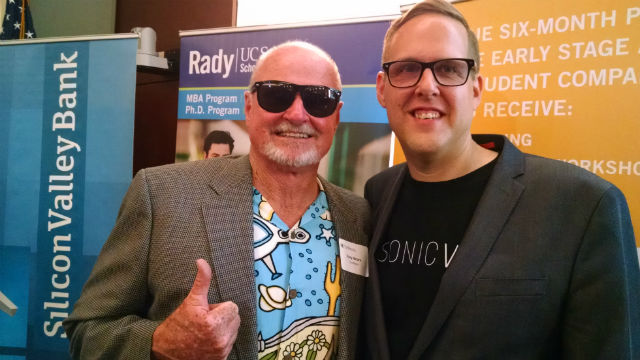Daily Business Report/Dec. 9, 2016
A surfer appears unaware as the USS Zumwalt transits the San Diego channel on its way to her new homeport at Naval Base San Diego on Thursday. (U.S. Navy photo by Petty Officer 2nd Class Timothy M. Black)
Zumwalt Comes Home
The Navy’s most technologically advanced surface combatant, USS Zumwalt, completed her journey to San Diego on Thursday.
Zumwalt’s arrival to her new Southern California homeport concluded a nearly four-month transit from Bath, Maine, which included training operations, various port calls, and a commissioning ceremony in Baltimore. Zumwalt departed Bath Iron Works shipyard Sept. 7 and made several port visits to eastern U.S. Navy fleet concentration areas, such as Norfolk and Mayport, Florida.

“We have looked forward to pulling in to San Diego for a long time,” said Commanding Officer Capt. James A. Kirk, about the crew’s excitement to arrive in San Diego. “I can’t express enough, how proud I am of the crew’s hard work in bringing Zumwalt to the West Coast.”
Due to Zumwalt’s status as a unique, first-in-class ship, sailors were engaged in training evolutions far away from San Diego in various ports, after reporting for duty to the pre-commissioning unit command in Bath. The crew of the Zumwalt took custody of the ship in May and rapidly made final preparations to take the new class of destroyer out to sea. The sailors went through taxing training and certification events before receiving authorization to depart the shipyard.
______________________

General Atomics Starts Flight Testing
Of Extended Range Gray Eagle Drone
General Atomics Aeronautical Systems Inc. announced the start of flight testing for its MQ-1C Gray Eagle Extended Range series. The successful first flight of the company’s production drone MQ-1C Gray Eagle ER aircraft from its El Mirage Flight Operations Facility in Adelanto, Calif., was on Oct. 29.
“The flight of our capital MQ-1C Gray Eagle ER UAS Unmanned Aircraft System) is a significant milestone in the continued evolution of the MQ-1C program with our U.S. Army customer,” said David R. Alexander, president of aircraft systems for General Atomics. “This marks the next step in delivering the aircraft’s increased endurance and payload capability to the warfighter.”
MQ-1C Gray Eagle ER, developed specifically to increase endurance and payload capacity, is a next-generation derivative of the combat-proven Gray Eagle UAS, which has accumulated over 300,000 flight hours since 2008. MQ-1C ER is expected to complete flight testing in June 2017, at which point it will begin a series of Army test events culminating in the program’s second operational test and evaluation in late 2017. The first four aircraft are expected to be delivered in the second and third quarter of 2017, with an additional 15 over the course of 2018.
According to the company, the extended range drone delivers an advanced medium-altitude long-endurance capability for the Army, adding increased payload capacity, greater range and endurance, and improved maintainability. The aircraft is engineered with a maximum gross takeoff weight of 4,200 pounds compared with Gray Eagle’s 3,600 pounds. With endurance at more than 40 hours, the aircraft will exceed the Army’s requirement for 14 hours on station at 1,000 kilometers for all mission types.
______________________

Lawnmowers of the Sea
Grazing on algae is a full-time job for a
highly specialized group of coral reef fish
By Annie Reisewitz
In a new study, a Scripps Institution of Oceanography-led research team examined the unique grazing roles of algae-eating herbivores on coral reefs to learn more about how they help keep corals from being overgrown by seaweeds.
Scripps marine ecologist Emily Kelly and her research team recorded the feeding behaviors of 15 of the most common species of algae-eating fish, such as parrotfish and surgeonfish on a coral reef in Maui, Hawaii. The study, conducted over a four-year period, compared these observations to the stomach contents of several of the fish species as well as the habitat in which different fish were grazing.
Kelly’s team discovered that despite large-scale similarities across all species in the consumption of “turf algae,” a group of algae comprised of a number of different species, a finer scale analysis revealed that individual species are actually selectively grazing on different types of algae and in different ways.
“These ‘lawnmowers’ on the reef are selective in the types of algae they consume and the impact of each bite,” said Kelly, lead author of the study and a postdoctoral scholar in the Scripps Coral Reef Ecology Lab. “These fish are in fact each a different type of gardening tool with a slightly different function in grazing.”
______________________
General Atomics, Nordion Get Funds
To Support Medical Isotope Production
ExecutiveBiz
General Atomics and Nordion will receive $15.3 million in funds from the Energy Department under the second phase of a cooperative agreement to produce commercial supplies of molybdenum-99 isotopes with the University of Missouri Research Reactor Center.
Nordion said Wednesday the Phase II funds from DOE’s National Nuclear Security Administration came more than a year after NNSA awarded $9.7 million in Phase I funds to General Atomics to support the Mo-99 production project.
Mo-99 serves as the parent isotope of the medical isotope technetium-99m used in nuclear-based diagnostic procedures.
Kathy Murray, Mo-99 project manager at General Atomics, said the company will use its selective gas extraction platform based on low-enriched uranium to produce Mo-99 isotopes.
“NNSA’s new funding will help ensure we achieve our goal of re establishing the routine North American commercial supply of molybdenum-99 by mid- to late-2018,” said Phil Larabie, general manager of medical isotopes at Nordion.
Nordion has agreed with the Canadian government and Canadian Nuclear Laboratories to maintain a commercial supply of Mo-99 through March 31, 2018.
______________________
Two San Diego Community College
District Trustees Get New Terms
San Diego Community College District Governing Board members Mary Graham and Bernie Rhinerson were sworn in to new four-year terms during the board’s Dec. 8 meeting. The board also unanimously re-elected Dr. Maria Nieto Senour for a second term as its president. She has served on the board since 1990.
Graham was re-elected for a third term. She represents District D, which includes Rolando Park, Paradise Hills, Oak Park, Encanto, Chollas Creek, Kensington, Talmadge, and Del Cerro. She was sworn in by district Chancellor Constance M. Carroll.
Rhinerson will serve his second term representing District B, which includes the communities of Mira Mesa, Kearny Mesa, Linda Vista, Scripps Ranch, Allied Gardens, and San Carlos. San Diego Unified School District Board Member Richard Barrera administered the oath of office to Rhinerson.
In addition to Trustee Senour’s re-election, the board elected Rhinerson as its executive vice president, Graham as vice president of institutional effectiveness, Rich Grosch as vice president of educational collaboration, and Peter Zschiesche as vice president of community development.
______________________

Garrison Keillor to Perform Jan. 25
At California Center for the Arts, Escondido
The California Center for the Arts, Escondido will present legendary humorist and author Garrison Keillor for an evening storytelling on Wednesday, Jan. 25, at 7:30 p.m. in the Concert Hall.
Keillor’s hilarious anecdotes will be delivered with that signature “down comforter” voice, dry sense of humor, massive charisma, and Midwest wisdom.
This is his final tour and appearance in San Diego.
Keillor is best known as the host of American Public Media’s “A Prairie Home Companion” from 1974-2016. A master storyteller, he began his radio career as a freshman at the University of Minnesota. He went on to work for Minnesota Public Radio in 1969, and later he hosted the first broadcast of “A Prairie Home Companion” in St. Paul, Minn. on July 6, 1974. The show ended in 1987, resuming in 1989 in New York as The American Radio Company, but eventually returned to Minnesota in 1993 to broadcast under its original name.
A film adaptation of the show, titled “A Prairie Home Companion”, was released in 2006 starring Keillor as himself alongside several acclaimed actors including Meryl Streep, Lily Tomlin, Lindsay Lohan, Woody Harrelson, John C. Reilly, and Tommy Lee Jones. After over 40 years of hosting “A Prairie Home Companion”, Keillor retired from the show in 2016 and the new host is mandolin virtuoso Chris Thile. Today, “A Prairie Home Companion” is heard by 3.5 million listeners each week on more than 700 public radio stations, and abroad on the American Forces Networks, SiriusXM Radio, Radio New Zealand, and KPRG in Guam.
______________________
Visualizing the Population of California:
How much space you’d need to store every Californian

An infographic from spare foot
From the Redwoods to the Sonoran Desert, the Golden State’s 38 million residents occupy a large area of the United States. Living in the second largest state gives Californians plenty of room to live, work, play, and you know, sit in traffic for hours on end.
Now, imagine for a minute what kind of pile up it would be if you got all the Angelinos, San Diegans, Sacramentans, Bakersfieldians, Reddingites, Oaklanders, Palo Altonians and everyone else to stand shoulder to shoulder in the same place?
Actually we did the math, and you might be surprised how much space you would need to store every single Californian together. We even adjusted for obesity, which being 40th in the country means Californians fit more compactly than most other states — just like their cars. And because we’re SpareFoot, we even tell you how many California storage units you’d need. Check out the infographic below:




